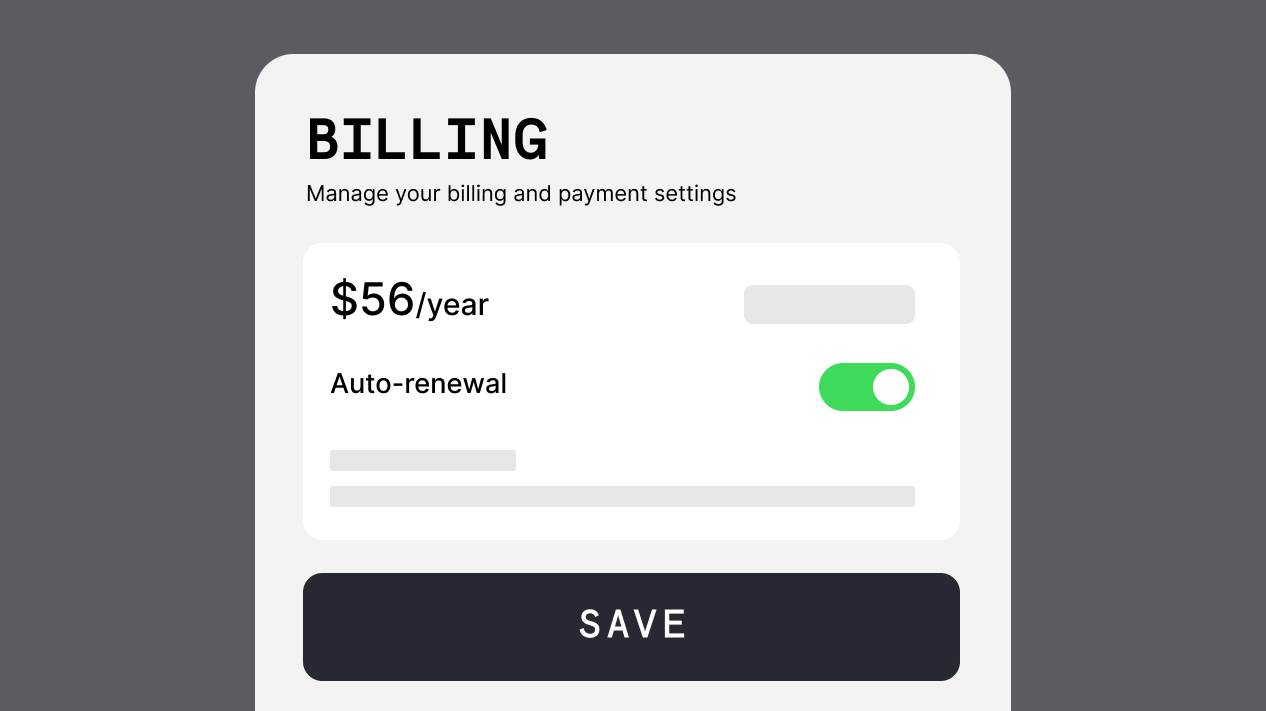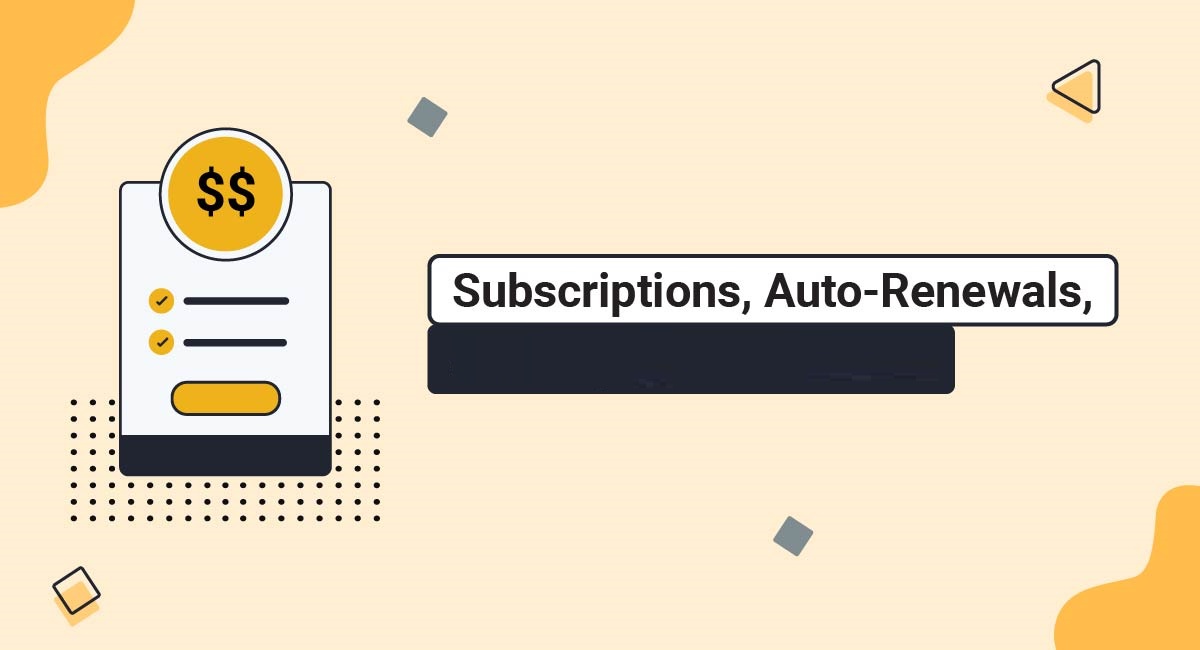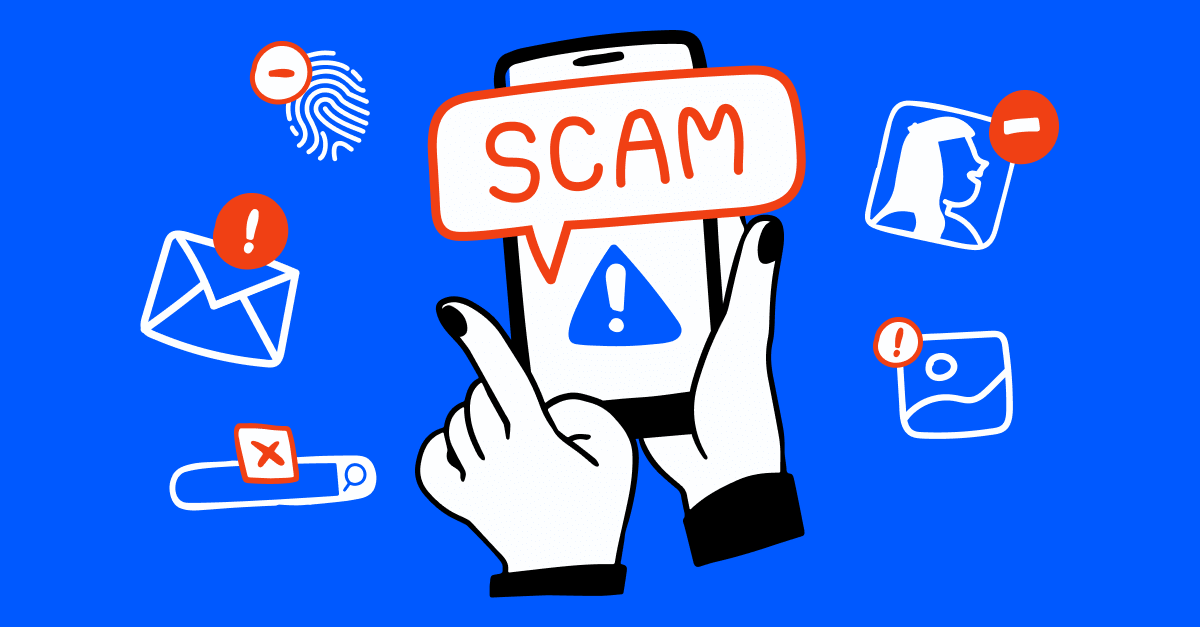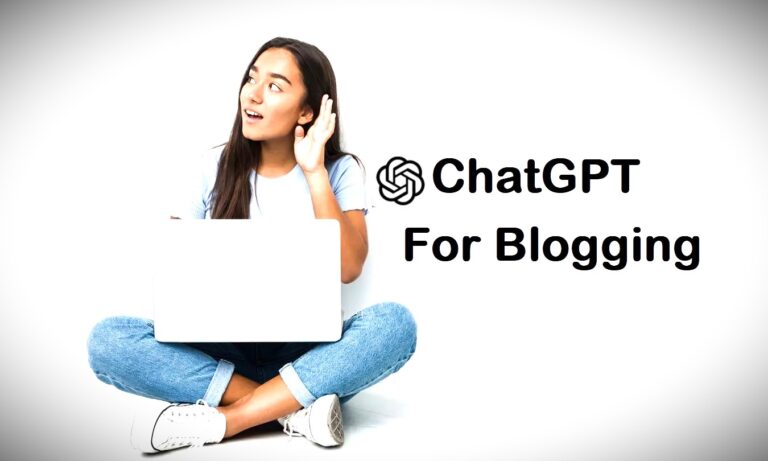My Software Subscription Auto-renewal Disasters (explained)

The dark side of software subscription auto-renewal (I learned the $2,300+ way)
A while ago, I got a notification that made my eyes twitch: “Your annual Canva Pro subscription has been renewed for $119.99.”
The problem? I hadn’t used Canva in eight months.
This wasn’t an isolated incident. After digging through my credit card statements like a forensic accountant, I discovered that software subscription auto-renewal scams had cost me $2,300+ this year alone.
And I consider myself pretty savvy about this stuff.
If you’re a blogger, content creator, or anyone who uses more than three software tools, you’re probably getting screwed, too.
Let me show you exactly how deep this rabbit hole goes.
The $2,300 Wake-Up Call 💰
Here’s the embarrassing breakdown of how I became a subscription zombie without realizing it:
Annual renewals that blindsided me:
- Canva Pro: $119.99 (hadn’t used in 8 months)
- Adobe Creative Suite: $599.88 (switched to Figma 6 months ago)
- Kit (formerly ConvertKit): $348 (moved to Beehiiv in March)
- Grammarly Premium: $144 (forgot I had this AND Hemingway)
- Zoom Pro: $179.90 (back to basic plan, never cancelled premium)
- Notion Pro: $96 (team plan for a team that disbanded)
Monthly subscriptions I forgot existed:
- Loom Pro: $96/year ($8/month I ignored for 12 months)
- Buffer Essentials: $72/year ($6/month on autopilot)
- Unsplash+: $228/year ($19/month, I never consciously agreed to)
- Three different stock photo sites: $287 combined
- Two project management tools: $318 combined
- Four AI writing tools: $516 combined (because apparently I’m a hoarder)
The worst part? Most of these renewals happened with zero warning, or with “notifications” buried so deep in my spam folder that they might as well have been invisible.
How I Became a Subscription Addict (Without Realizing It)

Let me paint you a picture of how this happens, because I bet it sounds familiar:
January: I need a tool for social media scheduling. Buffer looks good, let me try the free trial.
February: Free trial ends, but I’m busy with a client project. Sure, I’ll upgrade to keep using it.
March: Found a better tool (SocialBee), but Buffer is only $6/month, so whatever.
April-December: Completely forget Buffer exists while paying $6/month like a digital tithe to the subscription gods.
Multiply this scenario by 20+ tools over three years, and suddenly you’re paying rent on software you don’t even remember installing.
The psychology is diabolical. These companies make it stupid easy to sign up (one click, use your existing payment method!), but canceling requires navigating through more screens than a government website from 2003.
Sneakiest Auto-Renewal Tactics I Discovered

After getting burned repeatedly, I started documenting the shadiest practices I encountered.
Some of this shit should be illegal:
The Stealth Price Increase
What happens: Your monthly $10 subscription quietly becomes $15 without proper notification.
Example: My Tailwind subscription jumped from $9.99 to $14.99 per month. The “notification” was buried in a newsletter I never read, with the subject line “Exciting Updates to Your Tailwind Experience!” No mention of the 50% price hike in the subject.
The Feature Hostage Situation
What happens: They remove features from your current plan and force you to upgrade to keep what you already had.
Real example: Hootsuite moved bulk scheduling (a feature I used daily) from their $29/month plan to their $99/month plan. My options were to pay triple or lose core functionality.
The Fake Discount Trap
What happens: They offer a “limited time” discount that auto-renews at full price.
Example: Got Semrush for $69/month as a “special offer.” Twelve months later, boom – $199/month renewal with zero warning about the price jump.
The Platform Pivot Scam
What happens: The tool you signed up for completely changes focus, but your subscription continues.
Real example: Signed up for a writing tool that pivoted to become a project management platform. Still got charged monthly for a product that no longer existed in its original form.
The Impossible Cancellation Process
What happens: Canceling requires calling during business hours, multiple confirmation steps, or “accidentally” broken unsubscribe links.
Example: Tried to cancel a $47/month marketing tool. The cancellation link was broken for three weeks (convenient, right?), customer service had a 45-minute hold time, and they required a phone call to “verify cancellation intent.”
What’s the Real Cost of Subscription Bloat

Let me break down what subscription creep actually costs beyond the obvious monthly charges:
Direct Financial Impact
- Average monthly SaaS spending: $387 (up from $127 in 2021)
- Unused subscriptions: 64% of total spending
- Annual waste: $2,300+ (in my case, probably higher for bigger creators)
Hidden Opportunity Costs
- Time spent managing subscriptions: 2-3 hours monthly
- Mental bandwidth worrying about bills and auto-renewals
- Decision fatigue from constantly evaluating tools
- Cash flow unpredictability from surprise renewals
The Productivity Paradox
Here’s the kicker: having too many tools actually makes you less productive. I spent more time switching between platforms and remembering login credentials than I saved using “efficient” software.
Tools I actually used regularly: 8
Tools I paid for: 23
Efficiency gained: Negative (too much context switching)
My Great Subscription Audit of 2024

After my $2,300+ reality check, I went full Marie Kondo on my subscriptions.
Here’s exactly how I did it:
Step 1: The Inventory Nightmare
I gathered every credit card statement, PayPal transaction, and bank record from the past 18 months. This took four hours and three glasses of wine.
Discovery method:
- Searched email for “subscription,” “renewal,” “billing,” and “invoice”
- Checked credit card statements for recurring charges
- Used apps like Truebill (now Rocket Money) to catch ones I missed
- Reviewed Apple App Store and Google Play subscriptions
Shocking findings:
- 47 active subscriptions across all platforms
- 12 subscriptions to tools I’d never heard of (probably from “free” trials)
- 8 subscriptions I was paying for twice (different email addresses)
- 3 subscriptions to companies that no longer existed
Step 2: The Ruthless Evaluation
For each subscription, I asked three questions:
- Have I used this in the past 60 days?
- Does this solve a current, active problem?
- Is there a free alternative that works 80% as well?
If the answer to any question was no, it got axed immediately.
Step 3: The Consolidation Challenge
I realized I was paying for multiple tools that do the same thing:
Social media management: Buffer + SocialBee + Hootsuite
Solution: Kept SocialBee, cancelled the other two
Savings: $47/month
Design tools: Canva + Adobe Creative Suite + Figma
Solution: Kept Figma (free) + occasional Canva Pro monthly when needed
Savings: $69/month
Email marketing: Kit (formerly ConvertKit) + Mailchimp + Beehiiv
Solution: Consolidated everything to Beehiiv
Savings: $54/month
Step 4: The Prevention System
I created a subscription tracking system to prevent future disasters:
- Shared Google Sheet with renewal dates, costs, and last-used dates
- Calendar reminders 30 days before major renewals
- Monthly review process (15 minutes on the first of each month)
- New subscription rule: 30-day cooling-off period before upgrading from free trials
The Worst Offenders (Name and Shame Time)

Based on my experience and research, here are the platforms with the shadiest renewal practices:
Adobe Creative Cloud
The sin: Impossible to cancel, sometimes needs a call, has early termination fees, and constant upselling
The damage: $599/year for software I used twice
Pro tip: If you must use Adobe, pay monthly and cancel immediately after projects
Zoom
The sin: Automatically upgraded me to Pro when I hit usage limits during a busy month
The damage: $179 annual renewal, I never authorized
Pro tip: Monitor your usage and set hard limits in account settings
Most AI Writing Tools
The sin: Launching as “lifetime deals” then switching to subscription models
The damage: $516 across four different tools that all do the same thing
Pro tip: Stick with one AI tool and actually use it consistently
WordPress Plugin Subscriptions
The sin: Critical security updates locked behind renewals, plus they multiply like rabbits
The damage: $287 for plugins I installed once and forgot about
Pro tip: Audit your plugins quarterly and look for free alternatives
Tools That Help Fight Subscription Bloat 🛠
After getting burned, I found some legitimate tools that help manage this mess:
Truebill (Now Rocket Money) – Free with Premium Features
What it does: Finds and cancels subscriptions automatically
The good: Caught 8 subscriptions I’d completely forgotten about
The bad: Premium features cost up to $60/year (ironic, right?)
Verdict: Worth it if you have 10+ subscriptions
Honey (Browser Extension) – Free
What it does: Tracks subscription renewals and price changes
The good: Alerts you before renewals and finds discount codes
The bad: Limited to browser-based subscriptions
Verdict: Install it, it’s free and actually helpful. However, I have some problems with this after being accused of ripping off creators.
Bank/Credit Card Alerts – Free
What it does: Notifies you of recurring charges
The good: Catches everything, regardless of platform
The bad: It can be noisy if you have many subscriptions
Verdict: Essential for catching sneaky renewals
Personal Spreadsheet – Free
What it does: Manual tracking of all subscriptions
The good: Complete control and customization
The bad: Requires discipline to maintain
Verdict: Old school but effective if you’re organized (Drop me a message if you need it for free)
Psychology Behind Subscription Addiction
Let’s talk about why we keep falling for this shit, because understanding the psychology helps you avoid the traps:
The Sunk Cost Fallacy
“I’ve already paid for six months, might as well use it.” Wrong. The money is gone whether you use it or not. Don’t throw good money after bad.
FOMO and Tool Envy
Seeing other creators use shiny new tools triggers the “I need that too” impulse. But most tools solve problems you don’t actually have.
The Productivity Theater
We collect productivity tools like they’re Pokémon cards, thinking more tools = more productive. In reality, tool mastery beats tool collecting every time.
Decision Avoidance
It’s easier to ignore a $19/month charge than to research alternatives and switch platforms. But $19/month becomes $228/year quickly.
The Free Trial Trap
“I’ll just try it for free” is the gateway drug to subscription addiction. Set a calendar reminder to cancel BEFORE the trial ends, not after you get charged.
How to Negotiate with Subscription Services

Here’s something most people don’t know: you can often negotiate with subscription services, especially if you’re canceling. I’ve saved hundreds using these tactics:
The Cancellation Threat (Works 60% of the Time)
Script: “I’m planning to cancel my subscription. Do you have any retention offers available?”
Results: Got 50% off Grammarly for six months, a free month of Buffer Pro
The Competitor Comparison
Script: “I found a similar service for $X less. Can you match that price?”
Results: Hootsuite reduced my plan by $15/month to keep me from switching
The Downgrade Negotiation
Script: “I don’t need all these features. What’s your most basic plan?”
Results: Often, they’ll create custom plans or offer significant discounts
The Annual vs. Monthly Switch
Script: “I’ll commit to annual if you can discount it.”
Results: Most services offer 15-30% discounts for annual commitments
Pro tip: Always be polite but firm. These customer service reps have discretionary pricing power that they rarely mention upfront.
Tools I Keep (And Why) ✅
After my great subscription purge, here’s what survived and why:
Essential Tier ($67/month total)
Beehiiv: Email marketing that honestly delivers
Canva (Free): Design tool that replaced Adobe for 90% of tasks
Notion: Project management and content planning
Grammarly: Catches errors I miss (negotiated price)
SocialBee: Social media scheduling (only kept one)
Seasonal/Project-Based ($23/month average)
Canva Pro: Only pay when I need it for specific projects
Adobe Creative Suite: Monthly subscriptions for video projects only
Stock photos: Pay per image instead of monthly subscriptions
AI tools: Frase AI, when I’m writing heavily, cancel otherwise
Business Investment Tier ($89/month)
Kit (formerly ConvertKit): Back to this for advanced automation
Ahrefs: Split with two other bloggers
Zoom Pro: Actually need this for client calls
Total monthly spend: $179 (down from $387)
Annual savings: $2,496
Red Flags That Scream “Subscription Scam”

After getting burned repeatedly, I can spot problematic subscription services from a mile away. Watch out for:
During Sign-Up
- Requiring credit card info for “free” trials
- Pre-checked boxes for premium features
- Unclear pricing (what happens after the trial?)
- No obvious way to cancel during the signup process
- “Limited time offers” that pressure immediate decisions
In Their Terms of Service
- Automatic renewal clauses buried in legal text
- Early termination fees
- Right to change pricing with minimal notice
- Difficult cancellation requirements (phone calls only, business hours)
Red Flag Billing Practices
- Charging before trial periods end
- Vague invoice descriptions
- Billing from different company names than the service provider
- No confirmation emails for renewals
- Customer service that’s impossible to reach
Warning Signs in Marketing
- Promising unrealistic results (“10x your productivity!”)
- Fake scarcity (“Only 100 licenses left!”)
- Testimonials that seem too good to be true
- No clear pricing information on their website
- Aggressive retargeting ads after you visit
Read: AI for Blogging: Making Writers Lazy or More Productive?
Annual Subscription Audit Process
Here’s the exact system I use now to prevent future subscription disasters:
Monthly Check (15 minutes)
First Friday of every month:
- Review bank statements for new recurring charges
- Update subscription spreadsheet with usage notes
- Cancel anything I didn’t use in the past 30 days
- Set calendar reminders for upcoming annual renewals
Quarterly Deep Dive (2 hours)
Every three months:
- Audit all active subscriptions for necessity
- Research cheaper alternatives for the tools I use regularly
- Consolidate overlapping services
- Negotiate with services I’m keeping
Annual Planning Session (4 hours)
January budget planning:
- Project annual subscription costs
- Set subscription budget limits
- Identify tools to replace or eliminate
- Plan for seasonal needs (tax software, etc.)
Emergency Audit Triggers
Immediate review when:
- Monthly subscription spending exceeds the budget by 20%
- I receive surprise renewal charges over $50
- Credit card bills seem higher than expected
- I can’t remember what a recurring charge is for
Alternatives to Subscription Hell
Sometimes you can avoid subscriptions entirely with these strategies:
One-Time Purchase Software
- Sketch instead of Figma Pro
- Pixelmator Pro instead of Photoshop
- Bear instead of Notion Pro
- Things 3 instead of Todoist Premium
Free Alternatives That Don’t Suck
- GIMP instead of Photoshop (with a learning curve)
- Google Workspace instead of Microsoft 365 (for basic needs)
- OBS Studio instead of paid screen recording tools
- Audacity is instead of paid audio editing software
Usage-Based Pricing
- Pay-per-use stock photos instead of a monthly unlimited plan
- ChatGPT API credits instead of ChatGPT Plus
- Freelancer platforms for occasional design needs
Shared Subscriptions
- Split expensive tools (Ahrefs, SEMrush) with other bloggers
- Family plans for individual tools when available
- Team accounts are shared among mastermind groups
- Educational discounts if you qualify
How Companies Prey on Forgetfulness
Let me talk about some of the psychological tactics subscription services use to separate you from your money:
The Slow Boil Strategy
They start cheap, then gradually increase prices, betting you won’t notice $3-5 monthly increases until you’re paying double the original price.
The Feature Creep Upsell
Your plan suddenly doesn’t include features you used to have. Coincidentally, they’re now available in the “enhanced” tier for just $20 more per month.
The Abandonment Rescue
You try to cancel, and suddenly they have a “special retention offer” that was mysteriously unavailable before you threatened to leave.
The Complexity Shield
Making pricing so complicated (per user, per feature, per usage) that you can’t easily compare alternatives or predict your actual costs.
The Guilt Trip Cancellation
“You’ll lose all your data/settings/work if you cancel” – often untrue, but effective at preventing cancellations.
Finally: Take Control Before It’s Too Late
Here’s what losing $2,300+ to subscription auto-renewal disasters taught me: these companies are counting on your forgetfulness, busy schedule, and decision avoidance to pad their profits.
Software subscription auto-renewal isn’t inherently evil, but the current system is designed to benefit companies at your expense.
The solution isn’t to avoid all subscriptions – it’s to be intentional about what you pay for and ruthless about canceling what you don’t use.
The subscription economy isn’t going anywhere, but you don’t have to be its victim.
Set up systems, audit regularly, and don’t be afraid to cancel things. Your future self (and bank account) will thank you.
Start your audit today.
Seriously, stop reading this and go check your credit card statements. I guarantee you’ll find at least three subscriptions you forgot about.
And if you find something worse than my $2,300+ disaster story, please share it. Misery loves company, and we need to warn others about the subscription apocalypse that’s eating everyone’s budget alive.
FAQs
What’s the best app for tracking subscriptions?
I use a combination of Truebill for discovery and a Google Sheet for ongoing tracking. Bank alerts catch anything automated tools miss.
No single solution is perfect.
How often should I audit my subscriptions?
Monthly for a quick check, quarterly for deeper evaluation, and annually for comprehensive planning. Set calendar reminders or you’ll forget (like I did).
Can I get refunds for subscriptions I forgot about?
Sometimes. If you catch auto-renewals within 30 days and haven’t used the service, many companies will refund them. Be polite but persistent with customer service.
What’s the psychology behind subscription addiction?
It’s convenience, FOMO, sunk cost fallacy, and decision avoidance all rolled into one. Understanding these triggers helps you make more rational decisions.
Should I pay annually or monthly for subscriptions?
Monthly gives you flexibility to cancel, and annual plans usually offer discounts. I pay annually for tools I’m confident I’ll use, monthly for everything else.
How do I negotiate with subscription services?
Mention you’re canceling and ask about retention offers. Compare with competitors. Be willing to actually cancel if they won’t negotiate.
What are the biggest red flags for predatory subscription services?
Requiring credit cards for free trials, difficult cancellation processes, vague pricing, and automatic upgrades without clear consent.
How much should I budget for software subscriptions?
It varies by business, but I recommend starting with 5-10% of your monthly revenue and adjusting based on actual usage and ROI.
Are there any subscription services actually worth the money?
Yes, but only if you use them regularly and they solve real problems. Tools that save you time or make you money can justify their cost.
What’s the worst subscription practice you’ve encountered?
A marketing tool that automatically upgraded everyone to “enterprise” pricing during a product update, then made customers contact sales to downgrade. Took three weeks and multiple calls to fix.
Want more honest takes on the tools and services bleeding your budget dry? Subscribe to Blog Recode (yes, I see the irony), where I test everything so you don’t have to waste your money.





